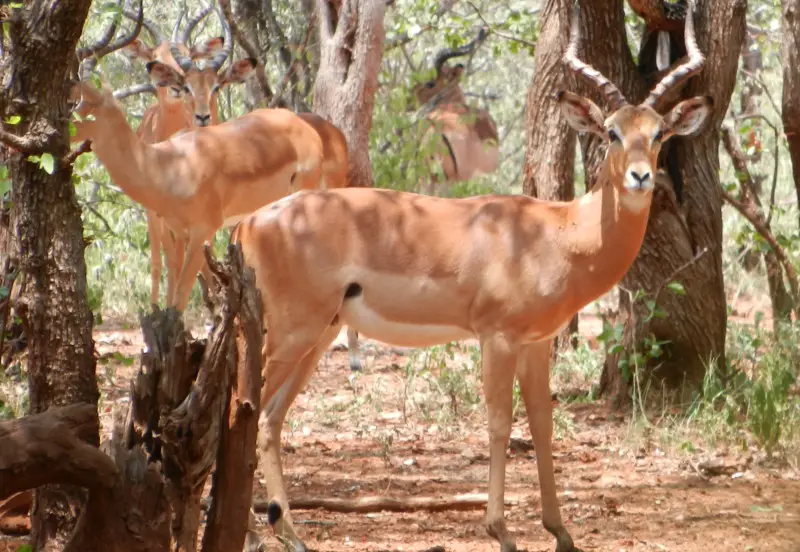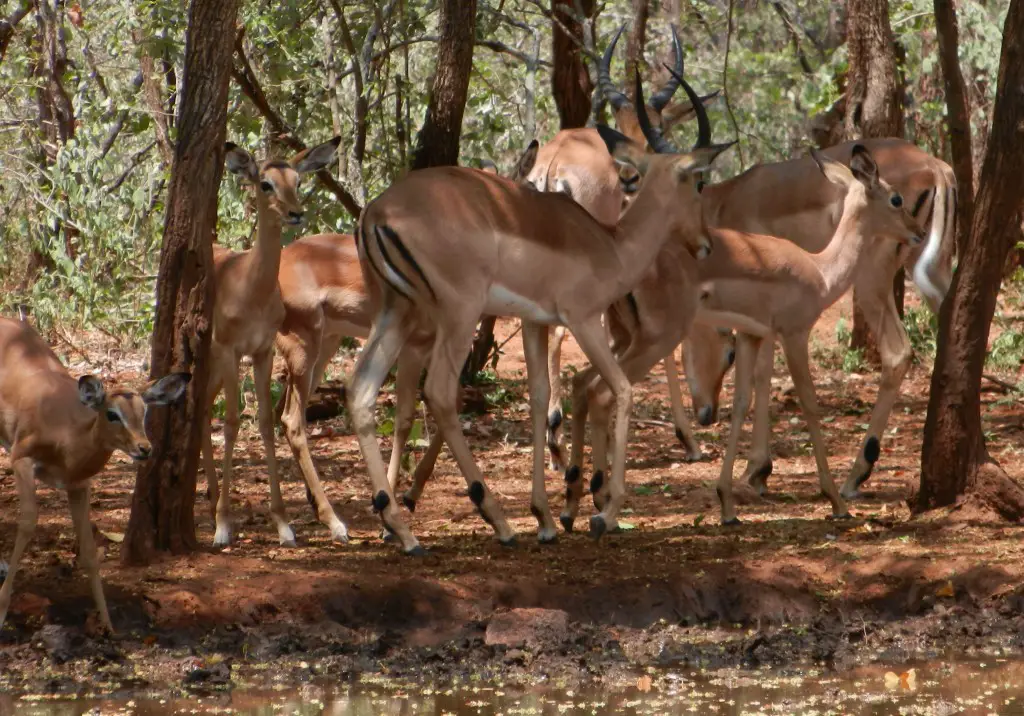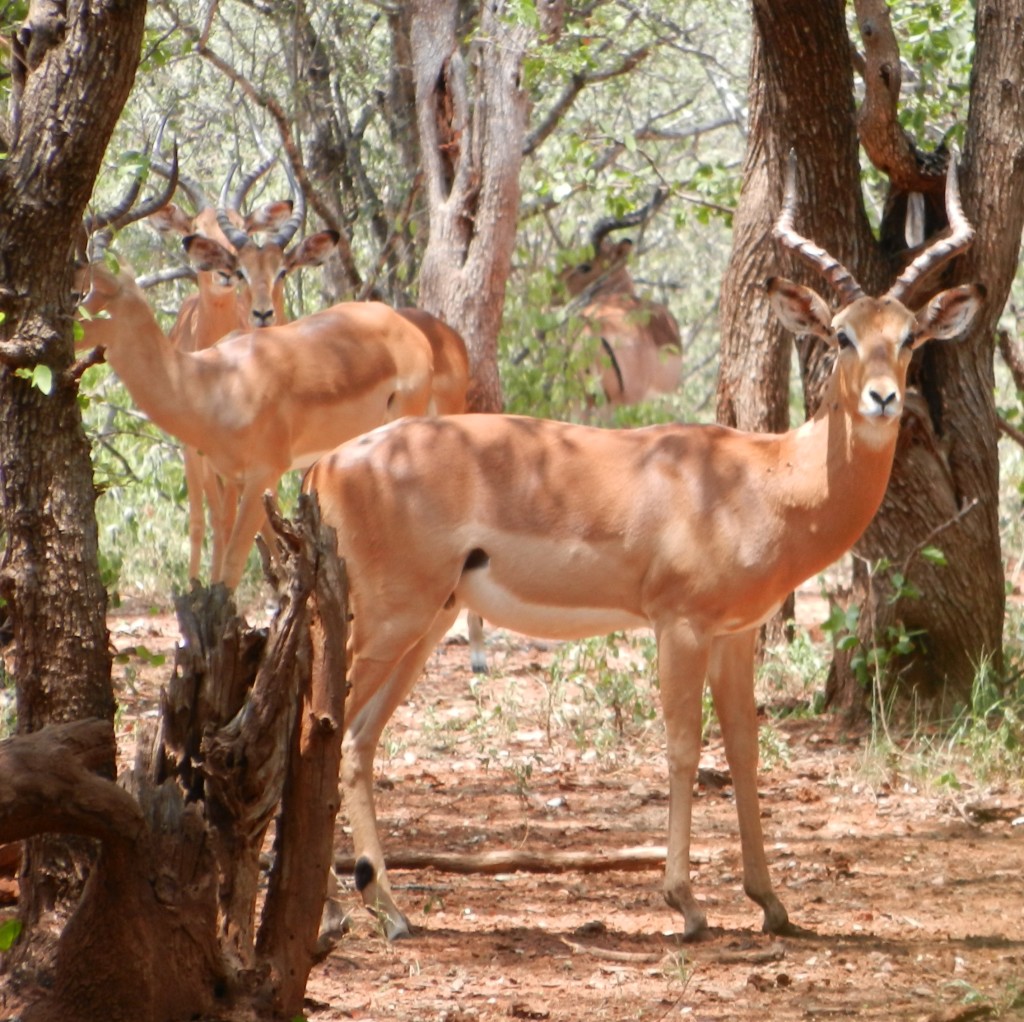This article is part of a series about some of the various species available for hunting in Africa (along with blue wildebeest, warthog, and zebra). In this series, I plan on describing the physical attributes and distribution of each species in addition to recommended hunting methods, recommended cartridges, and shot placement. My first article is about one of the most widely distributed and commonly hunted animals in Africa: the impala.
Description & Distribution
The impala is a medium sized antelope that is found in the savannahs and in some forests in Africa. Approximately the size of American white-tailed deer, males (rams) usually weighing from 90 to 170 pounds. They are sexually dimorphic, so females (ewes) are somewhat smaller, usually weighing 70-100 pounds. Impalas usually have a short, light brown colored coat on the back and flanks with a white underbelly. Only rams have horns, which grow longer and thicker as the ram ages.
Safari Club international recognizes three subspecies of impala: the East African Impala, the Southern Impala, and the Black-Faced Impala. All three subspecies are similar in size, but the East African variant has a slightly larger body and horns than the others. The East African Impala is typically found in Kenya, Tanzania, and Uganda. The Southern Impala is the most common of the three and is found in Tanzania, Mozambique, Zimbabwe, Zambia, Malawi, Swaziland, South Africa, Botswana, Namibia, and Angola.
Finally, Black-Faced Impala reside in northern Namibia and southern Angola.
They are gregarious animals and are typically found in herds ranging from a few dozen to hundreds of impala. Generally, ewes and fawns live in herds with one dominant ram while young rams live in bachelor herds, though this can change when conditions are tough a and food is scare. One thing to keep in mind is that they tend to bunch even closer together than usual when alarmed, so a hunter must take great care not to take a shot that would injure more than one impala.
Hunting Methods
There are several possible methods available for hunting impala. If it is legal in the area you will be hunting, and you consider it ethical, probably the easiest way to hunt them is to ambush herds from a blind overlooking a water hole. Another commonly used method is to attempt a stalk on a feeding herd during the morning or evening when they are most active. While this can still be a very successful hunting method, it can be very difficult to get inside shooting range because they have very good eyesight and one must avoid the watchful gaze of dozens of animals. It is best to go slowly and make the most of any available concealment, such as folds in the terrain or clumps of vegetation in order to get close enough for an ethical shot.
Recommended Cartridges
While they are not particularly large or tough animals, impala must still be given the proper amount of respect when choosing a caliber and bullet for hunting. In some areas it is legal to hunt them with .22 caliber centerfire rifles (.22 Hornet, .223 Remington, .220 Swift, etc.). However, I feel that these cartridges are on the light side for ethical hunting (culling is another matter entirely).
Due to the fact that longer range shots are often necessary when hunting impala, especially in windy, open savannah areas, I recommend using a relatively flat shooting cartridge in the 6mm to .30 caliber range. The .243 Winchester, .270 Winchester, .280 Remington, .280 Ackley Improved, 7mm Remington Magnum, and .30-06 Springfield are all calibers ideally suited to the challenges associated with impala hunting have taken more than their fair share of impala over the years.
However, consider that most hunters will hunt several other species that are both larger and tougher than impala (like cape buffalo) on a safari and often use one rifle to do so. With this in mind, there is absolutely nothing wrong with hunting impala with a larger, more powerful cartridge than those previously listed. Indeed, many hunters go on safari with only a .375 H&H or .375 Ruger and successfully hunt everything from klipspringer to elephant with it.
Whatever cartridge you end up choosing, ensure that you use controlled expansion, heavy for caliber bullets (e.g. 150-160 gr bullets for .270 Winchester, 180-220 gr bullets for .30-06, etc.).
Shot Placement
As with any animal, shot placement is extremely important on impala. Impala have an anatomy similar to most other antelope and shots on them are relatively simple. Due to the complexity of the shot and the high probability of wounding the animal, I do not recommend head or neck shots for hunters. Instead, I recommend the heart/lung shot in virtually any situation. When the impala is standing broadside, simply aim either on, or slightly behind the front shoulder and approximately one third of the way up the impala’s body. Just ensure that you compensate properly if the animal is quartering towards or away from you (aim slightly forward if the animal is quartering towards you and slightly to the rear if the animal is quartering away).
A shot there will hit the top of the heart along with the lungs and the impala will quickly expire if hit with a well constructed bullet. Aiming for this spot also has the advantage of giving the hunter a large margin of error; a bullet that hits slightly high, low, forward, or to the rear will still hit vitals and ensure a quick and ethical kill. This will allow for a relatively quick follow up and minimize the chances of losing the animal.
Impala are one of the most widely distributed species available for hunting in Africa, provide tasty fare for the table during a hunt, and offer a unique and beautiful trophy to take home. Additionally, they provide a relatively easy, yet still enjoyable hunting experience. Due to this, they are one of the most consistently popular species for hunters and I highly recommend them for those booking a trip to Africa, especially a first safari.
For what it’s worth, a hunt in Africa made the cut for my holiday gift recommendations. To see what other stuff is on the list, check out the following article:
Awesome Holiday Gifts For Hunters
Enjoy this article about hunting Impala? Please share it with your friends on Facebook and Twitter.
Make sure you follow The Big Game Hunting Blog on Facebook, Instagram, Twitter, and YouTube.
NEXT: READ THIS BEFORE HUNTING CAPE BUFFALO WITH THE .45-70 GOVERNMENT
The Perfect Shot by Kevin Robertson was used as a reference for shot placement.
John McAdams is a proficient blogger, experienced shooter, and long time hunter who has pursued big game in 8 different countries on 3 separate continents. John graduated from the United States Military Academy at West Point and is a veteran of combat tours with the US Army in Iraq & Afghanistan. In addition to founding and writing for The Big Game Hunting Blog, John has written for outdoor publications like Bear Hunting Magazine, The Texas State Rifle Association newsletter, Texas Wildlife Magazine, & Wide Open Spaces. Learn more about John here, read some of John’s most popular articles, and be sure to subscribe to his show: the Big Game Hunting Podcast.





